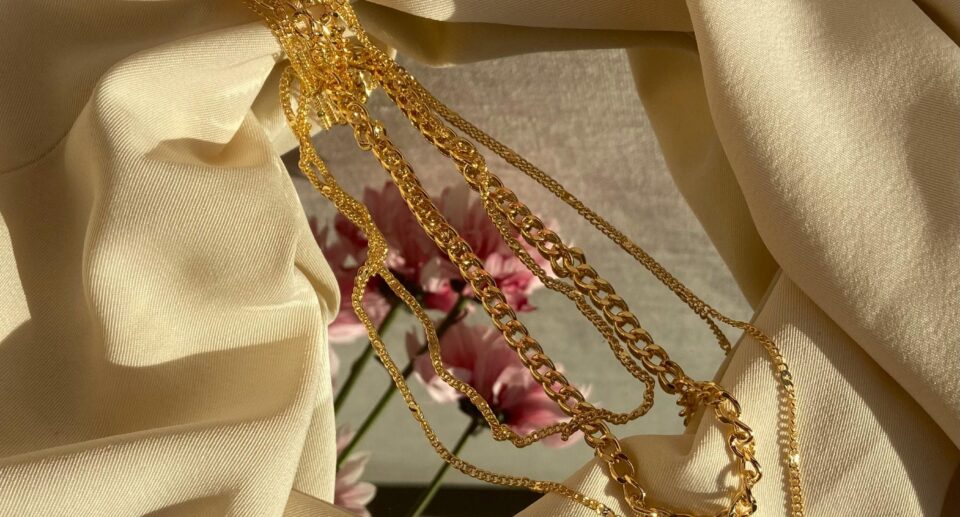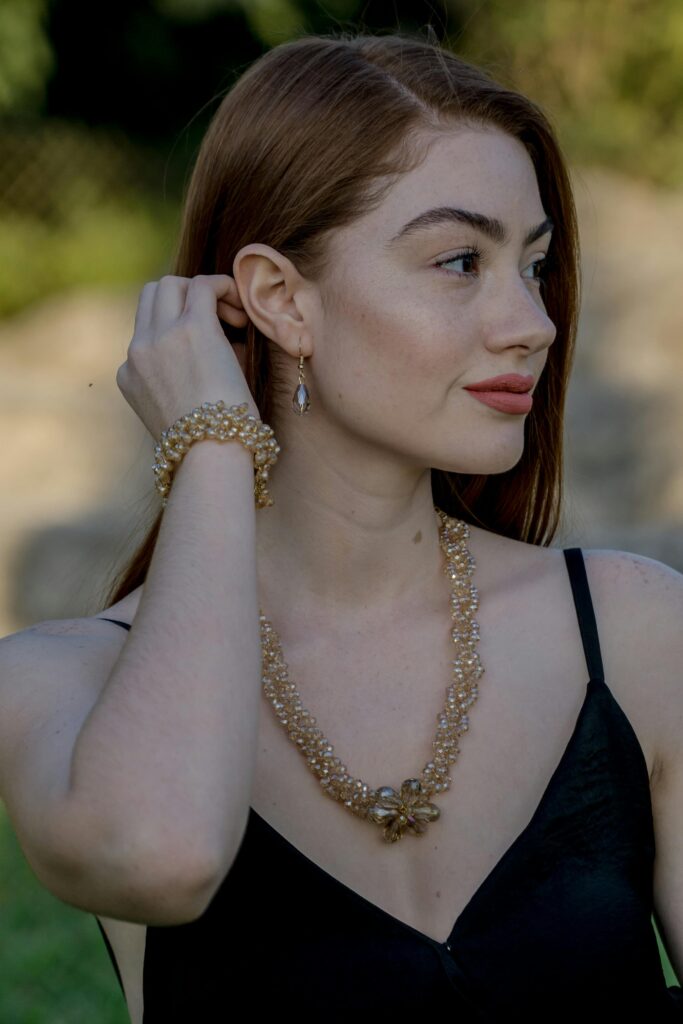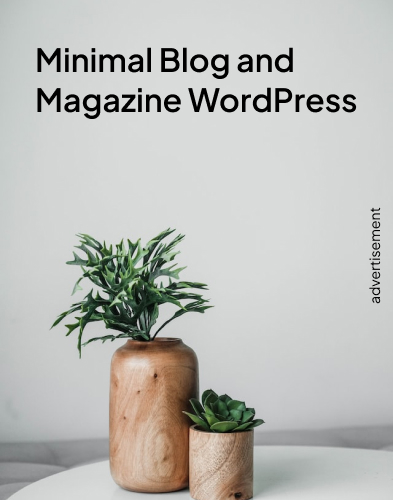
Jewelry refers to decorative items worn for personal adornment, such as necklaces, rings, bracelets, earrings, and brooches. These items can be made from a variety of materials, including precious metals like gold, silver, and platinum, as well as gemstones like diamonds, rubies, sapphires, and emeralds. Jewelry can also be crafted from less traditional materials such as glass, wood, and plastic.
Types of Jewelry
Necklaces: Worn around the neck, necklaces can range from simple chains to elaborate pendants or beaded designs.
Earrings: Worn on the earlobes, earrings come in various styles such as studs, hoops, and dangly designs.
Rings: Typically worn on the fingers, rings can signify various meanings, including engagement and marriage.
Bracelets: Worn around the wrist, bracelets can be made of metal, leather, beads, or fabric.
Brooches: Decorative pins that can be attached to clothing, adding a stylish touch to outfits.
Anklets: Worn around the ankle, anklets are often used in cultures around the world for various traditional and aesthetic purposes.
Materials Used in Jewelry
Precious Metals: Gold, silver, and platinum are the most common precious metals used in fine jewelry.
Gemstones: Diamonds, rubies, sapphires, and emeralds are highly valued and frequently used in jewelry.
Pearls: Formed within mollusks, pearls are often used in necklaces, earrings, and bracelets.
Alternative Materials: Contemporary jewelry may use materials like titanium, stainless steel, or even recycled materials.
Historical and Cultural Significance
Jewelry has been worn throughout history and across cultures for various reasons, including:
Symbolic Meanings: In many cultures, jewelry symbolizes wealth, status, and power. For example, ancient Egyptians used gold jewelry to signify status and religious beliefs.
Cultural Practices: In some cultures, jewelry is integral to traditional attire and ceremonies. For example, Indian weddings often feature elaborate gold jewelry.
Personal Expression: Modern jewelry is often used to express personal style and taste.
Care and Maintenance
Proper care can extend the life and luster of jewelry:
Cleaning: Regular cleaning with appropriate solutions or professional services keeps jewelry looking its best.
Storage: Store pieces in a dry, cool place, preferably in separate compartments to avoid scratches.
Maintenance: Regularly check for loose stones or damaged clasps and have them repaired promptly to avoid loss.
Jewelry continues to be a popular form of adornment and self-expression, evolving with trends while maintaining its timeless appeal.

Types of Jewelry (Continued)
Charms: Small decorative pendants or trinkets that can be attached to bracelets, necklaces, or anklets. They often carry personal significance or represent milestones and interests.
Cufflinks: Decorative fasteners worn by men and women to secure the cuffs of dress shirts. They are often made of metal and can be adorned with gemstones or engravings.
Body Jewelry: Includes items like nose rings, belly button rings, eyebrow rings, and more. These are typically used in body piercings and can be made from various materials suitable for the skin.
Tiara and Crowns: Often worn during formal occasions or by royalty, these headpieces can be adorned with precious metals and stones.
Hair Jewelry: Includes items such as hairpins, clips, and headbands that are decorated with gemstones, pearls, and other materials.
Jewelry Crafting Techniques
Casting: The process of pouring molten metal into a mold to create a desired shape. This technique is often used for creating rings and pendants.
Soldering: Joining two or more metal pieces together using a filler metal. This is a common technique for making intricate jewelry designs.
Stone Setting: The process of securely placing gemstones into jewelry. Various methods include prong setting, bezel setting, and pavé setting.
Enameling: Applying a glass-like coating to the surface of metal. This adds color and can be used to create detailed designs.
Filigree: Delicate metalwork featuring intricate patterns and designs, often resembling lace. It’s commonly used in vintage and antique jewelry.
Popular Gemstones and Their Meanings
Diamond: Represents purity, strength, and eternal love. It is the traditional birthstone for April.
Ruby: Symbolizes passion, protection, and vitality. Rubies are the birthstone for July.
Sapphire: Associated with wisdom, royalty, and divine favor. Sapphires are the birthstone for September.
Emerald: Represents rebirth, love, and fertility. It is the birthstone for May.
Amethyst: Known for its calming properties and is believed to promote clarity and balance. It is the birthstone for February.
Topaz: Thought to bring joy, generosity, and good health. Topaz is the birthstone for November.
Jewelry Trends
Minimalist Jewelry: Simple and understated designs that are versatile and can be worn daily. Popular choices include delicate chains and small stud earrings.
Statement Pieces: Bold and eye-catching designs that make a significant impact. These can include oversized necklaces, chunky rings, and vibrant gemstones.
Vintage and Antique Jewelry: Pieces from or inspired by past eras such as the Victorian, Art Deco, and Edwardian periods. These often feature intricate designs and craftsmanship.
Personalized Jewelry: Customizable items that can include initials, names, birthstones, or special dates. This adds a personal touch to the piece.
Sustainable Jewelry: Made from recycled materials or ethically sourced gemstones and metals. This trend focuses on environmental responsibility and ethical production practices.
Buying Jewelry
When purchasing jewelry, consider the following:
Certification: For gemstones, especially diamonds, look for certification from reputable organizations like the Gemological Institute of America (GIA).
Craftsmanship: Examine the quality of the work, including settings, clasps, and finishes.
Materials: Verify the authenticity of the metals and stones used. Look for hallmarks that indicate purity, such as 925 for sterling silver or 14K for gold.
Style and Preference: Choose pieces that match your personal style or the taste of the person you are buying for.
Budget: Set a budget and explore options within that range. There are beautiful pieces available at every price point.
Jewelry Care Tips
Avoid Exposure: Keep jewelry away from harsh chemicals, including household cleaners and chlorine. These can damage metals and stones.
Wear with Care: Remove jewelry when engaging in activities that might scratch or damage it, such as sports or heavy lifting.
Regular Inspection: Check for loose stones, worn prongs, or damaged clasps and have them repaired by a professional jeweler.
Professional Cleaning: Periodically have your jewelry cleaned and inspected by a professional to maintain its brilliance and integrity.
Jewelry remains a timeless and cherished way to express individuality, celebrate milestones, and honor traditions. Whether you are an aficionado of classic designs or a fan of modern trends, there is a vast world of jewelry to explore and enjoy.










